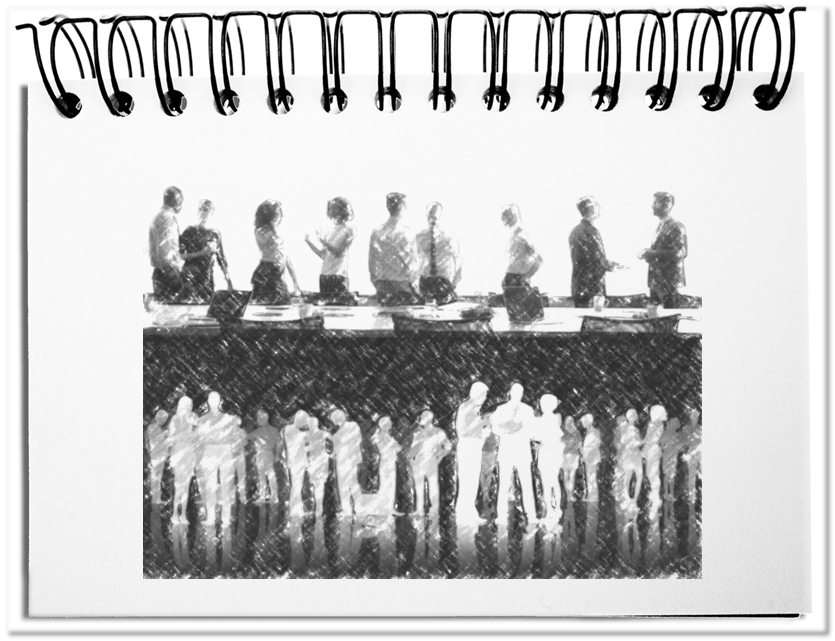How unimaginable seems to be a city that is gigantic and divided into a lower and an upper town. The border separates the two like the Berlin Wall the East- from the West-part of the city. There is no exchange of any kind. Since centuries the Upper dwellers and the Lower dwellers have forgotten the existence of each other. Above the sun never sets – below it never rises. As a result, people have adapted to their environment and speak in the meantime their own language, which sounds the same but transports different meaning. One day an explosion ruptures a huge crater, which connects the city from above with the one below. Both of them shut the crater off and recognize that they have direct neighbors, who even seem to speak their language. The boundary evaporates.
The first meetings are pleasant, since the languages are very similar and use even the same words. But then it becomes apparent that the two areas have developed in very different directions. The following examples show the differences.
- Visual perception
The city above has equipped over the centuries all areas that are not approached by sunlight with artificial light around the clock. That way they eventually forgot the darkness. It is similar to the city below. Over time the light has disappeared from the under town. After all, they forgot the light.
At the crater the Upper and the Lower dwellers get together. And they both say, “I can’t see.” An astonishing consensus, since both come from completely different surroundings. It takes a while for somebody to understand that they both mean something different. The Upper dwellers can’t see because they do not penetrate the darkness. And the Lower dwellers see nothing because they are blinded by the light. - Auditory perception
The hearing habits have also developed differently in the two neighborhoods. The dark corridors of the city below swallow up any sound waves after only a few yards. As a result, the hearing of the Lower dwellers has been readjusted to the low frequencies, whose long waves can still be heard far away. On the surface, the Upper dwellers enjoy the timbres created by the high frequencies.
After the crater formation, they meet in the crater and don’t believe what they hear. And they both say, “I hear something unusual.” The low tones irritate the Upper dwellers and the high sounds feel strange to the Lower dwellers. - Kinesthetic perception
Above and below ground, heat receptors have adapted to the respective habitats. The permanent sunshine and the artificial light tan the Upper dwellers and provide an even climate. In contrast, the Lower dwellers are quite pale and used to the wet freshness of the underground.
However, in the crater they are exposed to a new environment to which their thermal sensation reacts strongly and both say “I feel uncomfortable”. The unfamiliar coolness causes stress to the Upper dwellers and the unfamiliar heat to the Lower dwellers. - Olfactory perception
Both districts have got used to their atmosphere over a long period of time. In the city above there is always a high level of humidity, which transports smelling particularly well. In the absence of light, they have become accustomed to following their nose, which is able to distinguish their environment and recognize the fellow human beings by their scent. In the upper town the air is dry and transports few smells. Since they can rely on their eyes, they don’t pay much attention to scents.
In the crater, the two atmospheres meet and Upper and Lower dwellers say “It smells strange.” - Gustatory perception
Both districts have adapted their food to their environment. The Upper dwellers love spicy food that is eaten raw. The Lower dwellers prefer boiled food, which less irritates the taste buds, but bland with a moist, wide vapidness.
During the meetings in the crater, the delicacies of the kitchens are exchanged. And both say, “That’s inedible.”
Long story short. Radical constructivism postulates that there is no objective reality, but that everyone constructs his or her own personal image of the reality from his or her sensory stimuli and experiences. In the example above, we have performed a simple mental game that shows how our environment determines our way of expressing ourselves. Obviously, the Upper and Lower dwellers have lived far apart. They adapted ideally to their respective environment. Interestingly, however, their language has remained unchanged over the centuries. They may have forgotten some words that do not fit into their reality, but central utterances have survived. But they always mean something completely different. Our senses provide visual, auditory, kinesthetic, olfactory and gustatory stimuli, which we mix with our experiences to eventually express ourselves – in our example with the same words for different meanings.
Bottom line: Since Descartes, we have been trying to explore the world objectively. Today, we know that our perception is not in a position to provide a joined reality. Science has long recognized this. However, we are still trying to objectify everything. The above example is intended to show in the simplest possible way, how different the world can be perceived, depending on one’s own view and experience. We can use these insights in our daily communication by being aware of the following.
First: It is the listener, not the speaker, who supplies meaning to an utterance. (Heinz von Foerster).
Second: You cannot not communicate (Paul Watzlawick).
In everyday life this means that one should again and again be aware of the natural limits and to make an effort to understand the counterpart.

